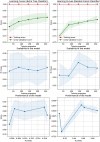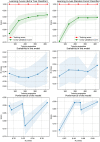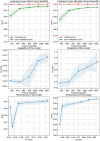Role of convolutional features and machine learning for predicting student academic performance from MOODLE data
- PMID: 37939093
- PMCID: PMC10631652
- DOI: 10.1371/journal.pone.0293061
Role of convolutional features and machine learning for predicting student academic performance from MOODLE data
Abstract
Predicting student performance automatically is of utmost importance, due to the substantial volume of data within educational databases. Educational data mining (EDM) devises techniques to uncover insights from data originating in educational settings. Artificial intelligence (AI) can mine educational data to predict student performance and provide measures to help students avoid failing and learn better. Learning platforms complement traditional learning settings by analyzing student performance, which can help reduce the chance of student failure. Existing methods for student performance prediction in educational data mining faced challenges such as limited accuracy, imbalanced data, and difficulties in feature engineering. These issues hindered effective adaptability and generalization across diverse educational contexts. This study proposes a machine learning-based system with deep convoluted features for the prediction of students' academic performance. The proposed framework is employed to predict student academic performance using balanced as well as, imbalanced datasets using the synthetic minority oversampling technique (SMOTE). In addition, the performance is also evaluated using the original and deep convoluted features. Experimental results indicate that the use of deep convoluted features provides improved prediction accuracy compared to original features. Results obtained using the extra tree classifier with convoluted features show the highest classification accuracy of 99.9%. In comparison with the state-of-the-art approaches, the proposed approach achieved higher performance. This research introduces a powerful AI-driven system for student performance prediction, offering substantial advancements in accuracy compared to existing approaches.
Copyright: © 2023 Abuzinadah et al. This is an open access article distributed under the terms of the Creative Commons Attribution License, which permits unrestricted use, distribution, and reproduction in any medium, provided the original author and source are credited.
Conflict of interest statement
The authors have declared that no competing interests exist.
Figures








Similar articles
-
AI-driven educational transformation in ICT: Improving adaptability, sentiment, and academic performance with advanced machine learning.PLoS One. 2025 May 19;20(5):e0317519. doi: 10.1371/journal.pone.0317519. eCollection 2025. PLoS One. 2025. PMID: 40388422 Free PMC article.
-
Predicting Students' Academic Performance with Conditional Generative Adversarial Network and Deep SVM.Sensors (Basel). 2022 Jun 26;22(13):4834. doi: 10.3390/s22134834. Sensors (Basel). 2022. PMID: 35808330 Free PMC article.
-
Student dropout prediction through machine learning optimization: insights from moodle log data.Sci Rep. 2025 Mar 21;15(1):9840. doi: 10.1038/s41598-025-93918-1. Sci Rep. 2025. PMID: 40119104 Free PMC article.
-
Integrating artificial intelligence to assess emotions in learning environments: a systematic literature review.Front Psychol. 2024 Jun 19;15:1387089. doi: 10.3389/fpsyg.2024.1387089. eCollection 2024. Front Psychol. 2024. PMID: 38966729 Free PMC article.
-
Assessment and Evaluation of Different Machine Learning Algorithms for Predicting Student Performance.Comput Intell Neurosci. 2022 May 9;2022:4151487. doi: 10.1155/2022/4151487. eCollection 2022. Comput Intell Neurosci. 2022. PMID: 35586111 Free PMC article.
Cited by
-
Novel deep reinforcement learning based collision avoidance approach for path planning of robots in unknown environment.PLoS One. 2025 Jan 16;20(1):e0312559. doi: 10.1371/journal.pone.0312559. eCollection 2025. PLoS One. 2025. PMID: 39821118 Free PMC article.
-
Enhancing tertiary students' programming skills with an explainable Educational Data Mining approach.PLoS One. 2024 Sep 3;19(9):e0307536. doi: 10.1371/journal.pone.0307536. eCollection 2024. PLoS One. 2024. PMID: 39226285 Free PMC article.
References
-
- Oda Abunamous M, Boudouaia A, Jebril M, Diafi S, Zreik M. The decay of traditional education: A case study under covid-19. Cogent Education. 2022;9(1):2082116. doi: 10.1080/2331186X.2022.2082116 - DOI
-
- Hernández JAC, Alberico AB, Duarte MP, Dellatorre P, Reinoso AJ, Beardo JMD. Teamwork assessment in collaborative projects through process mining techniques. The International journal of engineering education. 2020;36(1):470–482.
-
- Palomo-Duarte M, Dodero JM, Medina-Bulo I, Rodríguez-Posada EJ, Ruiz-Rube I. Assessment of collaborative learning experiences by graphical analysis of wiki contributions. Interactive Learning Environments. 2014;22(4):444–466. doi: 10.1080/10494820.2012.680969 - DOI
-
- Maldonado-Mahauad J, Pérez-Sanagustín M, Kizilcec RF, Morales N, Munoz-Gama J. Mining theory-based patterns from Big data: Identifying self-regulated learning strategies in Massive Open Online Courses. Computers in Human Behavior. 2018;80:179–196. doi: 10.1016/j.chb.2017.11.011 - DOI
MeSH terms
LinkOut - more resources
Full Text Sources

